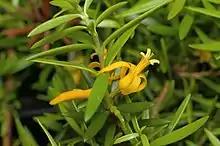Persoonia recedens
Persoonia recedens is a species of flowering plant in the family Proteaceae and is endemic to a restricted area of New South Wales. It is a spreading to low-lying shrub with hairy young branchlets, narrow oblong to narrow elliptic leaves, and yellow flowers borne in groups of up to twelve on a rachis up to 75 mm (3.0 in) that continues to grow after flowering.
| Persoonia recedens | |
|---|---|
 | |
| Scientific classification | |
| Kingdom: | Plantae |
| Clade: | Tracheophytes |
| Clade: | Angiosperms |
| Clade: | Eudicots |
| Order: | Proteales |
| Family: | Proteaceae |
| Genus: | Persoonia |
| Species: | P. recedens |
| Binomial name | |
| Persoonia recedens | |
Description
Persoonia recedens is a spreading to low-lying shrub that typically grows to a height of 0.3–1.5 m (1 ft 0 in – 4 ft 11 in) with smooth bark and sparsely to moderately hairy young branchlets. The leaves are narrow oblong to narrow elliptic, 10–20 mm (0.39–0.79 in) long and 1.2–3.5 mm (0.047–0.138 in) wide. The flowers are arranged in groups of up to twelve on a rachis up to 70 mm (2.8 in) long that continues to grow after flowering, each flower on a pedicel 2–3.5 mm (0.079–0.138 in) long with a leaf at its base. The tepals are yellow, 9–10 mm (0.35–0.39 in) long and glabrous. Flowering occurs from December to January.[2][3][4]
Taxonomy
Persoonia recedens was first formally described in 1919 by Michel Gandoger in the Bulletin de la Société Botanique de France from specimens collected by Carl Walter near Blackheath in 1882.[5][6]
Distribution and habitat
This geebung grows in forest on sandstone between the Newnes Plateau and Blackheath in New South Wales.[3][4]
References
- "Persoonia recedens". Australian Plant Census. Retrieved 3 November 2020.
- "Persoonia recedens Gand". Flora of Australia Online. Department of the Environment and Heritage, Australian Government.
- Weston, Peter H. "Persoonia recedens". Royal Botanic Garden Sydney. Retrieved 3 November 2020.
- Weston, Peter H. "Persoonia recedens". Australian Biological Resources Study, Department of Agriculture, Water and the Environment: Canberra. Retrieved 3 November 2020.
- "Persoonia recedens". APNI. Retrieved 3 November 2020.
- Gandoger, Michael (1919). "Sertum Plantarum Novarum. Pars secunda". Bulletin de la Société Botanique de France. 66: 227. Retrieved 3 November 2020.